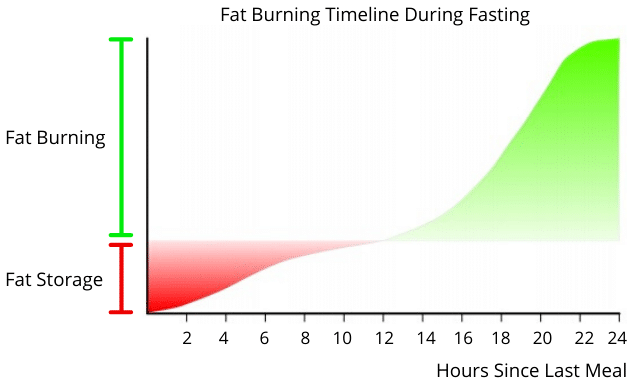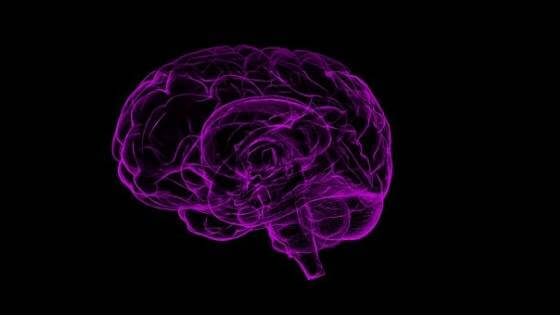Whether you’re looking to start fasting for weight loss or autophagy, it’s important that you get familiarized with the stages of fasting and what happens to your body during each.
Here’s what we’ll cover in this article:
Table of Contents
Stages of Fasting
The Fed State (0 – 6 hours)
After having your last meal, blood glucose levels rise. The increase in blood glucose will promote insulin secretion.
Insulin secretion will stimulate protein synthesis and serve as a signal to move glucose into the cell to be used as energy, the excess glucose will then be stored in the liver in the form of glycogen.
The liver will store glycogen to reduce blood glucose and have energy during times of low food availability.
The liver, however, can only store around 100 g of glycogen (2); once that limit is reached, the excess is stored as fat in a process called de novo lipogenesis. (3)
The Postabsorptive Stage (6 – 24 hours)
After 6 hours, blood glucose levels start to decrease; this leads to a decrease in insulin and an increase in glucagon, furthermore, the liver breaks down glycogen into glucose to be used as energy.
When there’s no intake of glucose, glucagon will serve to move glycogen stores as well as to prevent fatty acid synthesis.
Gluconeogenic Stage (1 – 2 days)
After 24 hours, you’ve used most of your glycogen stores.
Consequently, your body starts transitioning from using glucose to using fat for energy.
However, due to fats being difficult to access and be delivered where needed, this transition can take some time.
Meanwhile, your body breaks down amino acids into glucose for energy in a process called gluconeogenesis (neo: new, genesis: creation, gluco: glucose).
This is why many people believe fasting makes you lose muscle mass.
Explore More: Will Intermittent Fasting Damage Your Metabolism?
Ketogenic Stage (2 – 3 days)
One of the stages of fasting is the ketogenic stage.
At this point, your body starts entering ketosis.
The decrease in insulin serves as a signal of low energy availability and promotes the break down of fats for energy (lipolysis).
Fats (triacylglycerols) are broken down into three fatty acids and glycerol.
Fatty acids will be used as energy by most tissues.
Glycerol, on the other hand, will be used to produce glucose, since some other tissues, such as the brain and red blood cells still need it.
Due to the massive amounts of energy the brain requires, the limited amount of glucose available, and the inability of fatty acids to cross the blood-brain barrier, the body needs to produce ketone bodies. (4)
Ketone bodies can cross the blood-brain barrier and supply the brain with the energy it needs.


Protein Conservation (4+ days)
After day four, your body relies mostly on fatty acids and ketones for energy. It also releases high amounts of human growth hormone to maintain lean tissues and muscle mass.
The synthesis of glucose from glycerol and the release of fatty acids by adipose tissue help maintain healthy blood glucose levels.
Some studies suggest that intermittent fasting – in the form of alternate-day fasting – doesn’t decrease your resting metabolic rate as much as caloric restriction due to the change in fuel source and the increase in norepinephrine.
How Long Do You Have to Fast Before You Start Burning Fat?

Depending on how big was your last meal, you can expect to start burning fat after fasting for 6-24 hours.
For most people, it ends up being around 12 hours.
When you enter a fasted state, your body can burn the stored fat that it couldn’t access during the fed state.
This is why most people who start keto for weight loss also implement intermittent fasting.
You can read more in this article about how long it takes to see results on keto.
Lose your first 5-10 pounds in just 1 week.
Get the FREE 7-Day Keto Challenge!

What is Fasting?
Most people associate fasting with religious practices, however, it is more than that.
Today, fasting is used by a lot of people for weight loss and its incredible health benefits, such as autophagy.
Fasting consists of refraining from all or some foods for a length of time.
The most common length for a fast is between 24-72 hours.
However, some people prefer to do intermittent fasting.
TAKEAWAY
Fasting is purposely abstaining from eating for a certain period of time.
What is Intermittent Fasting?
Intermittent fasting is when you cycle between periods of eating and fasting, typically going for a few hours or days.
Here are the most common forms of intermittent fasting:
- 12/12: fast for 12 hours with a 12-hour eating window.
- 16/8: fast for 16 hours with an 8-hour eating window.
- 20-4: fast for 20 hours with a 4-hour eating window.
- One Meal a Day (OMAD): fast for around 23 hours with a 1-hour eating window.
- Alternate Day Fasting (ADF): fasting every other day.
- 5:2: eating 5 days a week and fasting for 2 days.
Explore More: Intermittent Fasting Benefits on Cancer, Alzheimer’s, and Aging
Hourly Benefits of Fasting

- 4-8 Hours. Blood sugar and insulin levels drop.
- 12 Hours. Food eaten has most likely been burned, digestive system starts resting, body begins the healing process, human growth hormone (HGH) increases, and glucagon is released to balance blood sugar.
- 14 Hours. HGH keeps increasing and body begins to burn fat as energy.
- 16 Hours. Fat burning increases.
- 18 Hours. HGH increases even more.
- 18-20 Hours. Autophagy starts to kick in and ketones are released.
- 36 Hours. Autophagy increases by 300%.
- 48 Hours. Cellular regeneration starts, and inflammation starts going down.
- 72 Hours. Autophagy peaks.
Autophagy and Fasting
Besides weight loss, the most common reason people fast is for autophagy (cellular regeneration).
During fasting, since you’re not eating, your body is not getting enough nutrients.
This lack of nutrients will force your body to break down old proteins and cells to get energy.
Basically, autophagy forces your body to clean out the old, unwanted, and unneeded cells, as well as recycling and fixing damaged parts.
During the period of refeeding, your body then starts creating new cells. (5)
Many people use fasting for autophagy to treat excess skin from weight loss (skin is made up of some protein) and to prevent cancer by destroying old cells. (6)
Note: taking BCAAs while fasting will turn off autophagy. Autophagy is regulated by mTOR, a nutrient sensor that is very sensitive to protein.
How Long Do You Have to Fast for Autophagy?

While it can be a little difficult to measure when exactly autophagy starts to kick in, experts agree that it typically happens after a 18-20 hour fast.
When Does Autophagy Peak?
The max benefits from autophagy peak at the 24-72 hour mark.
If this sounds difficult to you, remember that intermittent fasting will still give you some of the benefits.
However, to get the full benefits of fasting, you might want to incorporate a long fast at least once or twice a year.
Signs of Autophagy
Here’s a list of a fews sign of autophagy to look out for:
- High Ketone Levels. High ketone levels are an indicator that your glycogen stores are being emptied and your entering ketosis and autophagy.
- Low Blood Sugar. Low blood sugar will cause your body to increase cortisol, growth hormone, and ketone production. This will promote fat oxidation and ketosis, which happens before autophagy.
- Reduced Appetite. If you’re not getting hungry after fasting for 24 hours, chances are you’re producing tons of ketones and your body has begun to eat its own body fat (that’s basically what autophagy means so no need to worry).
- Healthier Skin. It’s completely normal to get wrinkles and skin damage as you age due to oxidative stress. Autophagy often happens in the skin fibroblasts, which helps to keep a healthy skin. A sign of autophagy is the clearing of the skin.
Benefits of Autophagy
Autophagy has many great health benefits, such as:
- Eliminating lingering bacteria or viruses from infections.
- Ramping up the production of growth hormone.
- Clearing out old and unwanted proteins and cellular materials.
- Increasing longevity.
- May help prevent the development of Alzheimer’s, Parkinson’s, and some cancers.
TAKEAWAY
Autophagy forces your body to clean out the old, unwanted, and unneeded cells, as well as fixing and recycling damaged parts.
12 Hour Fast
Doing a 12 hour fast is great for beginners who want to start losing weight and getting some of the other health benefits from fasting.
This is because most of the fast happens while you sleep.
Here’s an easy way to do a 12 hour fast:
- Finish eating your last meal by 7 p.m.
- Wait until 7 a.m. to have your breakfast.
You can obviously play around with the time depending on your schedule.
16 Hour Fast
As previously mentioned, 16/8 is one of the most common ways of fasting.
Here’s how you could do a 16 hour fast:
- Finish your evening meal by 8 p.m.
- Skip breakfast and wait until noon to have lunch.
36 Hour Fast
Due to its length, a 36 hour fast (alternate day fasting) can offer more health benefits than a 12 or 16 hour fast.
The only rule in a 36 hour fast is that you can only have zero-calorie drinks, such as water, black coffee, and tea.
Interestingly, some studies (11, 12, 13) showed that a few people even find a 36 hour fast much easier to stick to than regular calorie restriction.
48 Hour Fast (5:2)
If you’re thinking about doing a 48 hour fast, you should make sure that you eat healthy/nutrient-dense foods the other 5 days.
How to Do It
One of the most common ways to do a 48 hour fast is to stop after dinner on the first day and start eating again on the third day at dinner.
Since dehydration is a common complication of longer fasts, it’s important that you stay super hydrated. (14)
Just like the 36 hour fast, you want to focus on zero-calorie drink, such as water, black coffee, and tea.
Reintroducing Food
After your 48 hour fast is over, you want to slowly reintroduce food.
This will prevent you from overstimulating your gut, which could lead to bloating, diarrhea, and nausea. (15)
You can try having a small snack, such as a serving of almonds to break the fast, and then have a small meal 1 or 2 hours later.
72 Hour Fast
This is probably the longest you could fast without medical supervision.
If you’re thinking about fasting for longer than 72 hours, make sure to talk to your doctor first.
Rules for the 72 hour fast are the same as the 48 and 36 hour fasts.
You should drink plenty of fluids. Most people drink about 2 to 3 liters of liquid per day.
Some people may also experience dizziness, therefore, make sure you’re not driving or using heavy machinery when fasting for 72 hours. (16)
Reintroducing Food After a 72 Hour Fast
Just like the 48 hour fast, you want to slowly reintroduce food to prevent overstimulating your gut.
While it typically takes about a day to feel comfortable eating larger meals again, it could take up to 3 days for some.
TAKEAWAY
During a fast, it’s recommended to only drink calorie-free drinks, such as water, black coffee, and tea, and start with a 12 or 16 hour fast before moving to a longer one.
Fasting Myths
1. You Will Go Hypoglycemic
Hypoglycemia is a condition caused by very low levels of blood sugar (glucose).
As mentioned before, your body will keep a balance in blood sugar levels by breaking down glycogen (during the first stages of fasting) and glycerol (after 4 days of fasting) to create glucose.
Note: fasting while taking medications to lower blood sugar can, indeed, cause hypoglycemia. Needless to say, you should consult with your physician before starting any dieting protocol.
2. Metabolic Damage (starvation mode)
During periods of caloric deficit, the body adapts to the deficit by reducing the number of calories it burns.
For instance, if your maintenance is 2,000 cal and you decrease your intake to 1,500 cal, eventually your metabolism will adapt and make 1,500 your new maintenance.
People often believe that the same happens when fasting, but even worse because you are eating zero calories.
That’s not really the case.
Since you need calories to merely stay alive, your body doesn’t just reduce your basal metabolic rate (BMR) to zero. Instead, it switches from glucose to fat as a fuel source.
Studies show that short-term fasting may cause a temporary increase in BMR due to hormonal alterations and changes in fuel source. (9)
These changes in hormones and fuel source might help explain why BMR doesn’t decrease as rapidly during alternate day fasting as it does during caloric restriction.
Alternate Day Fasting causes a decrease in insulin and an increase in norepinephrine that tells your body to give access to your fat stores.
The body then realizes it has enough energy and attenuates the decrease in BMR. (10)
TAKEAWAY
Controlled fasting will most likely not cause hypoglycemia or damage your metabolism.
Fasting Precautions
Just because fasting has many health benefits doesn’t mean that everyone should do it.
It’s recommended that children, pregnant or breastfeeding women, and people who are underweight do not fast, as these people are in need of essential vitamins, minerals, and nutrients.
People taking medications or currently dealing with type 1 or type 2 diabetes should talk to their physicians before starting a fast or any dieting protocol.
TAKEAWAY
It’s not recommended for children, pregnant or breastfeeding women, and underweight individuals to fast for long periods of time.
Stages of Fasting Summary
Here’s a quick summary about the stages of fasting:
- Fed State (0-6 hours after eating): insulin levels increase and the body starts storing excess glucose as glycogen.
- Postabsorptive Stage (6-24 hours): insulin starts dropping and your body breaks down glycogen into glucose for energy.
- Gluconeogenic Stage (1-2 days): glycogen stores have been depleted, consequently, your body makes glucose from the break down of amino acids.
- Ketogenic Stage (2-3 days): your body starts entering ketosis, a state where fatty acids and ketones meet most of your energy needs. At this point, the break down of amino acids starts decreasing.
- Protein Conservation Stage (4+ days): the body releases high amounts of human growth hormone and norepinephrine to maintain lean tissue and muscle mass.
If you loved this article about the stages of fasting, what happens when you fast and are ready to start your weight loss journey, the Custom Keto Diet plan is the place to start!

This plan helps men and women lose fat without starving themselves or giving up their favorite foods.






Yes I enjoyed reading the article.
1. Is there any effect on kidney by keto diet.
2. It was written that some kind of cancer can die by fasting for longer period. Why not all types of cancer cells?
Thanks for a well detailed information on stages of fasting, very educative and inspiring.
You didn’t mention anything about taking vit C, or sea salt, or magnesium (say citrate) when water fasting, especially during longer periods.